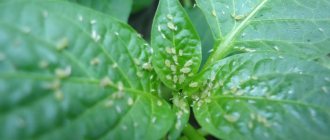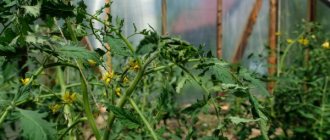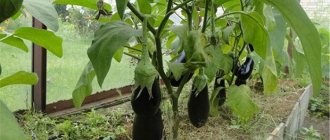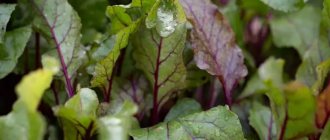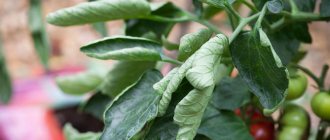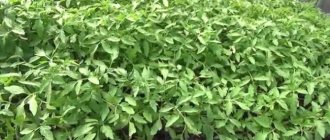Leaves that curl downwards or upwards appear on the bushes, the leaf blade itself often changes color - such damage is typical not only for adult plants, but also for seedlings. The condition of the leaves directly affects the entire plant, which also affects the desired result - the harvest.
Why do tomato leaves curl and how can I help the plants?
There are a large number of reasons why the top and remaining leaf blades of tomatoes curl down, up and inward. Everything is determined by how well the plants are cared for. Regardless of the method of growing tomatoes, in a greenhouse or in open ground, errors in care can be made. They can be identified by carefully checking the care technology and the conditions in which the plant develops.
Roots are damaged
The most important vegetative organ of any plant, the root, feeds it with mineral salts and water from the soil. If it is damaged, this function is immediately disrupted, the plant begins to slowly die, showing external signs of the disease in every possible way. The root can be touched completely accidentally when performing basic agrotechnical care techniques, such as:
- loosening;
- transplantation;
- digging.
At the same time, the plant becomes more susceptible to various diseases. Quite often, within the 1st day after transplanting seedlings, you can observe how the leaves curl into a “ram’s horn”.
What to do: you will need additional feeding with drugs that stimulate growth, root formation and immunity.
The plants are hot
High temperatures in areas where tomatoes are grown can be detrimental to plants. As the temperature rises, the leaves begin to release moisture more strongly, and the process of evaporation on the surface of the leaf plate - in the stomata - is activated.
What to do:
- If the heat catches the tomatoes in the greenhouse, it is necessary to ensure constant ventilation and shade the plants during the day so that less scorching sun rays fall on them.
- If the crop grows in the garden, it is necessary to control and increase watering as the air temperature increases, focusing on how moist the soil is.
Infrequent or excessive watering
Speaking about watering, it is necessary to indicate its basic rules. Tomatoes do quite well in warm climates. They do not require frequent watering; watering once a week is enough. If the temperature rises to 20-25 degrees Celsius, it is necessary to water twice as often; when the temperature increases by another 5 degrees, watering must be done after 2-3 days.
What to do: if the soil dries out quickly, it is recommended to water it every day.
No matter how intense the heat, you should not allow water to stagnate at the roots of plants or water too often - this will lead to rotting of the roots.
Lack or excess of fertilizers
Fertilizers are an important factor for obtaining a good harvest. Neglecting them or, on the contrary, abusing them is dangerous. Many symptoms of their deficiency or excess are immediately reflected in the condition of the leaves.
What to do:
- if there is a lack of fertilizers, you will need to feed the plants;
- if there is an excess, take a break from applying fertilizers for 2-3 weeks.
Lack of phosphorus, copper, potassium, nitrogen or calcium
- With a lack of nitrogen, the leaves of the plant appear yellow and dull, appear burnt and lifeless. Fertilizing with urea will correct the situation.
- With a lack of copper, the leaves curl and become white at the edges. Copper sulfate will help solve this problem.
- If young leaves do not have enough calcium, they appear to be scorched at the edges. The leaf blade itself acquires multiple light yellow spots. Larger older leaves darken and look rich. In such cases, calcium nitrate is recommended.
- A dark border on rolled leaves is a characteristic sign of plants that lack potassium. Any potash fertilizer will do.
- A lack of phosphorus causes the stem and leaves to turn blue-violet. To nourish the plant, phosphorus-containing fertilizers, such as superphosphates, are used.
Excess nitrogen or zinc
Applying fertilizers in large quantities will not improve the condition of plants and the amount of harvest, but, on the contrary, can destroy them.
- With an excessive concentration of nitrogen in the soil, weakening of the upper leaves is observed; they are noticeably smaller in size than the lower ones.
- With an excess of zinc, the color of the stem changes (it turns purple). The leaves themselves, despite regular watering, look exhausted, as if they are suffering from drought, and soon dry out and fall off.
What to do: You should refrain from using these fertilizers if the listed signs become clearly visible.
Dry air and too much light are the reasons for seedlings to wilt
With increased dryness in the room, the leaves of the seedlings begin to curl upward.
If it is not possible to achieve normal humidity in the room, then irrigate the space where the tomato seedlings are located with water from a spray bottle once a day.
If the room temperature is high, you can lower it by ventilation. The main thing is that the seedlings at this time are not exposed to drafts.
You can humidify the air near the seedlings, which are located next to the heating radiator, with a damp towel that is used to cover the radiator.
The leaves of tomato seedlings curl when exposed to direct sunlight. When seedlings are grown on a windowsill and exposed to the sun, be sure to provide diffused lighting. To do this, white paper is glued to the glass. Then direct sun will not hit the seedlings.
You can also remove containers with tomato seedlings from a sunny windowsill. Optimally, this is a window on the western or eastern side.
But plants will also suffer from lack of lighting. If seedlings are grown in February or March, then additional lighting devices are installed for the plants. For example, phytolamps.
✦ This is interesting: How to properly illuminate seedlings on the windowsill with a phytolamp?
If the leaves on adult plants curl from the sun, then the way out of this situation is shading the bushes. Often gardeners set up canopies for plants during the hot sun.
Due to mechanical damage to the seedling, the upper leaves may curl after pinching, when it was abundant and simultaneous. The lateral stepson shoots need to be cut off gradually, no more than two, over several days. This procedure is painlessly tolerated by plants.
The foliage curls when the seedlings have grown, and they are cramped in the container.
You will have to urgently transplant it either into a larger container or to a permanent place.
The leaves curl inward when the root system is damaged during transplantation. When damaged, seedlings do not receive the required amount of nutrients and react by curling their leaves. Additional feeding corrects the situation.
Diseases
Along with improper care, diseases can also harm tomatoes, which are often more difficult to combat than any other causes of leaf curl. An experienced gardener and agronomist can accurately identify the disease to combat its pathogen. But it is also useful for those who are just starting to grow cultivated plants in the garden to know about this. Some diseases are easy to detect due to noticeable external signs.
Bacterial cancer
Bacterial canker in tomatoes is a disease caused by a bacterium. It can manifest itself as wilting of plants, in this case affecting the vascular system, and spotting on leaves and fruits, as well as numerous dark ulcers.
It is transmitted by seeds, so it is important to choose high-quality planting material. When tomatoes are infected with bacterial canker, the leaf blades first curl upward and then wither.
Bacteriosis
Bacteriosis is one of the most dangerous diseases for nightshades, which affects the plant from the inside, although external signs may appear only after a couple of months. The disease manifests itself by leaf curling in the last stages of seedling development. And at first the sprouts do not look healthy enough.
The plant cannot be cured. To prevent contamination of the soil and other crops, tomatoes are uprooted and burned, followed by chemical treatment.
Thin leaf virus
The thin leaf virus cannot be cured; the leaves curl into thin “strings”. Infected plants must be destroyed. The virus is transmitted through seeds, so you need to choose only quality ones.
Stolbur
A dangerous disease - stolbur - inhibits the development of the plant. Fruits and flowers almost do not develop and become smaller. The leaves of affected plants become smaller, curl upward, and take on a boat shape.
It is carried by cicadas. The causative agent is phytoplasma, it affects every cell of the plant and cannot be cured, so the tomato must be burned.
Fusarium
Fusarium is a disease in tomatoes caused by fungal pathogens. It develops only on fruit-bearing plants. Fungicides are a good preventative measure.
It spreads from bottom to top, first affecting old leaves. The leaves turn light green, then curl and fall off.
Verticillium
Fungal diseases in their course and external manifestation in tomatoes are very similar, therefore, without laboratory diagnostics, it is impossible to accurately determine what fungal disease the plant is suffering from - fusarium and verticillium are very similar.
When watering, fungal spores rise up the shoot (upward current) - this explains the wilting process that occurs from bottom to top. Tomato leaves turn yellow and curl their tips upward. Then they fall off, and the plant can live for a long time.
Tobacco mosaic virus
The tobacco mosaic virus primarily affects young, immature plants. Newly planted seedlings have deformed leaf edges or even drying and falling leaves - this is the main sign of the disease, known to every gardener.
No. 1 Physiological causes of leaf deformation
Curled leaves of indoor hibiscus
For its growth and development, any plant requires the presence in the environment of various nutritional compounds, as well as substances critically necessary for maintaining vital functions. In particular, the plant needs amino acids to form tissues. Plants obtain oxygen and hydrogen from air and water, nitrogen from the soil, and carbon necessary for the production of sugars (as a result of photosynthesis) from carbon dioxide present in the atmosphere.
Theoretically, this is enough for normal growth, but that’s not all. To control the processes occurring in tissues, special microelements are also needed. Their concentration is very small in comparison with the substances already mentioned, but without their presence the plant will die.
Liquid complex fertilizer is used
Such substances include:
- magnesium, which is necessary for the formation of chlorophyll molecules;
- iron, which acts as a catalyst for photosynthesis;
- potassium (promotes the accumulation of sugars and prevents them from breaking down quickly);
- boron, necessary for the formation of plant germ cells;
- phosphorus, which serves to speed up metabolic processes;
- etc.
These are only the main components necessary for the normal functioning of the plant body. About a third of the periodic table is somehow involved in regulating their growth and reproduction processes. Naturally, a lack of certain substances leads to disruptions in the normal life of the plant.
It is also important to understand that not only a deficiency, but also an excess of some components can cause leaves to curl. For example, excessive doses of potassium fertilizers can sometimes have the completely opposite effect.
Curled leaves on young tomatoes with an excess of potassium fertilizers
As a result of research, it was found that leaf curling in young plants is associated with a lack of molybdenum, boron, magnesium and copper. In older adults, there is a deficiency of potassium, magnesium and fluoride.
Another reason may be the presence of substances in the soil or air that are frankly harmful to plants. Thus, chlorine, in almost any form, is dangerous for plants, since, being an element of group 7, it reacts with almost all components and accumulates in plants in large quantities. This leads to metabolic disorders and is the cause of many diseases of ornamental crops.
Curled leaves on indoor Saintpaulias
But it is not only the absence or excess of certain mineral “building blocks” that leads to such results. The influence of external factors plays an important role. For example, a sudden change in temperature, light or humidity caused by drafts, cold watering, shading, etc. can lead to disruption of the normal rhythms of plant life and cause deformation of its leaves and stems.
Next, we will consider the most common causes that cause changes in the shape of leaves and describe methods on how to eliminate their unpleasant consequences.
What to do to prevent the phenomenon?
The best remedy in the fight against plant diseases is prevention. Measures taken in advance can protect plants from disease and damage, and also guarantee a good harvest. After considering all the possible causes of leaf curling, you can briefly formulate the basic rules that should be followed in caring for tomatoes. Proper care is simply necessary for such fastidious plants.
Avoid overheating tomatoes
On hot summer days, tomatoes are most exposed to the scorching rays of the sun. Plants planted in open ground are more difficult to protect than those placed in a greenhouse. Shading the plant is the best solution to the problem. If the heat takes your garden by surprise, you can prevent the soil from drying out by more carefully controlling your watering.
Water correctly
It is recommended to water the plants no more than once a week, provided that the air temperature is stable. Tomatoes are heat-loving and do not require much water in normal weather.
It is necessary to water each bush at the root - such requirements are determined by the structure of the root system of tomatoes. The main root goes deep underground, so the taproot system requires such a distribution of moisture so that it reaches the root.
Avoid excess moisture at the roots
Excessive moisture also has a negative effect on the crop. Moisture promotes root rot and inhibits the development of the root system. Regular transfusion of water also disrupts the taste of tomatoes and prevents the absorption of beneficial substances from the soil.
Proper care
Any changes noticed in the early stages of development are much easier to prevent than to try to save a dying plant. Errors in care can usually be corrected quickly and easily.
Impact of improper transplantation
If the flower was transplanted according to all the rules, and after that the foliage began to deform, then most likely the fault may be the incorrect chemical composition of the soil that was used during replanting.
Therefore, you need to re-transplant into a good substrate , and at the same time try to root the cuttings in a separate container so as not to lose your varietal flower.
If the leaves curl after replanting, it needs to be repeated.
